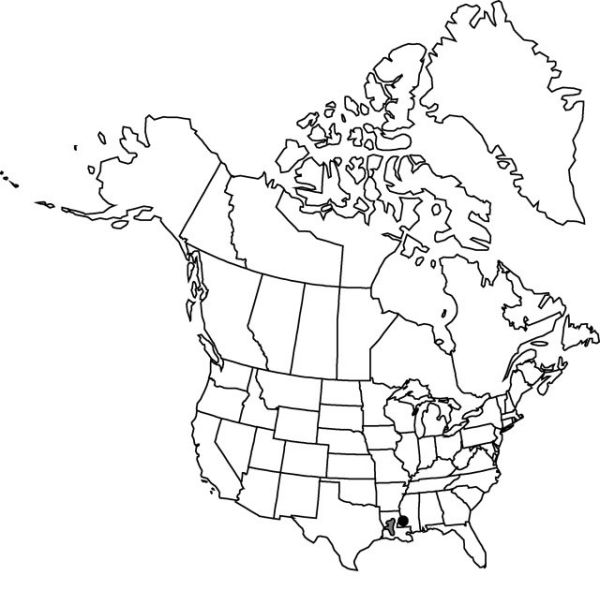Trillium ludovicianum
Biltmore Bot. Stud. 1: 23. 1901.
Rhizomes ± horizontal, brownish, short, thick, praemorse, not brittle. Scapes 1–3, round in cross-section, 1.4–2.6 dm, ± slender, glabrous. Bracts held well above ground, sessile; blade strongly mottled in dark and bronzy green, often with central light strip, mottling becoming somewhat obscure with age, lanceolate-ovate, 5.3–9.5 × 2.3–5 cm, not glossy, margins of distal 1/3 convex-curved to apex, apex rounded-acute. Flower erect, odor of carrion; sepals displayed above bracts, spreading, green, lanceolate-oblanceolate, 19–35 × 2.7–4 mm, margins entire, apex rounded or acute to sometimes weakly reflexed; petals long-lasting, faintly introrsely curved-erect-spreading, weakly connivent, ± concealing stamens and ovary, dark maroon-brown, purplish, or dull greenish, or 2-colored, basal portion purple, distal portion grayish green, not spirally twisted, oblanceolate-linear, 3.5–5.5 × 0.4–0.8 cm, thick-textured, thickened and weakly clawed basally, margins entire, apex acute; stamens erect, straight, 10–18 mm; filaments olive-orange, 2–3 mm, widened basally; anthers erect, straight, olive to orange, 7–20 mm, slender, dehiscence latrorse; connectives olive to orange, straight, scarcely extended beyond anther sac; ovary purple, ovoid, 6-angled, 8–9 mm; stigmas erect, with spreading or coiled tips, distinct, pale-purple, subulate, 3–6 mm, ± fleshy. Fruits dark purplish green, little or no odor, ovoid, 6-angled, pulpy.
Phenology: Flowering late winter–early spring (early Mar–Apr).
Habitat: Low flatwoods, floodplains along streams, steep ravine slopes leading to floodplains, mixed pine-beech woods
Elevation: 50–500 m
Discussion
The range of Trillium ludovicianum is near to that of T. cuneatum in Mississippi, and the two appear to intergrade.
Selected References
None.
Lower Taxa
"compressed-shortened" is not a number. "elongated" is not a number."thick" is not a number."dm" is not declared as a valid unit of measurement for this property."thicker" is not a number.
